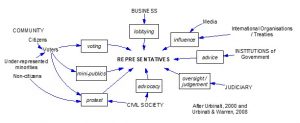Peter W Tait, 2020
Some background theory for explaining CAPaD’s objective in focusing on representation in participatory democratic theory.
- From Urbinati N, Warren ME. The concept of representation in contemporary democratic theory. Annual Review of Political Science. 2008;11:387-412
How do we know if representation is legitimate? This depends on the answer to two key generic questions to be asked of electoral and non-elected representatives:
(a) How are the representatives authorized by those in whose name they act?
(b) How are they held accountable by those they claim to represent?
p.407 “Given the complex and evolving landscape of democracy, however, neither the standard model of representation nor the participatory ideal can encompass the democratic ideal of inclusion of all affected by collective decisions. To move closer to this ideal, we shall need complex forms of representation—electoral representation and its various territorially based cousins, self-authorized representation, and new forms of representation that are capable of representing latent interests, transnational issues, broad values, and discursive positions.”
Representation as transcendence of the partisan here and now into the wider societal future.
- Urbinati N. Representation as advocacy: a study of democratic deliberation. Political theory. 2000;28(6):758-86.
p.760 “I have been inspired by three main ideas. First, public discourse is one of the main features that characterize and give value to democratic politics. Second, indirectness (and representation, which is a type of indirectness) plays a key role in forging the discursive democratic character of politics. Third, representation highlights the idealizing and judgmental nature of politics (its reflexivity, in contemporary terminology), an art by which individuals transcend the immediateness of their experience and interests, and “educate” their political judgment on their own and others’ opinions.12 Representation—and the electoral trial that is a necessary part of democratic representation—projects citizens into a future-oriented perspective, and thus confers politics an ideological dimension.13 In this sense, it gives ideas full residence in the house of politics. Representation is a comprehensive filtering, refining, and mediating process of political will formation and expression. It shapes the object, style, and procedures of political competition. Finally, it helps to depersonalize claims and opinions, and in this way makes them a vehicle for the mingling and associating of citizens. Representation can never be truly ‘descriptive’ of society because of its unavoidable inclination to transcend the ‘here’ and ‘now’ and to project instead a “would-be” or “ought-to-be” perspective.”
- See Adam Przeworski, Democracy and the Market: Political and Economic Reforms in Eastern Europe and Latin America (Cambridge: Cambridge University Press, 1991), 18.
- Mark Kishlansky, Parliamentary Selection: Social and Political Choice in Early Modern England (Cambridge: Cambridge University Press, 1986), 225-30. In his fascinating reconstruction of the transition from “selection” to “election” in seventeenth-century England, Kishlansky shows that the institutionalization of the electoral form of selection brought ideology into politics thus engendering a process of identification between the candidate and his constituency: “Unity now meant the agreement of the like-minded.”
- 761 “the two main political functions of representation, as a means both for expressing individual opinions and choices and therefore exercising self-government and for resisting exclusion and therefore achieving security.”


Leave a Reply
You must be logged in to post a comment.